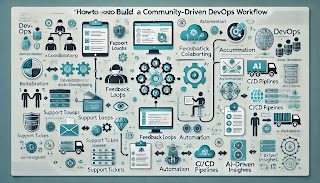How to Build a Community-Driven DevOps Workflow
In the dynamic landscape of DevOps, streamlining workflows is essential for achieving efficiency, speed, and collaboration. Leveraging insights from your developer community is one of the most effective ways to enhance your DevOps processes. By gathering real-world feedback, you can identify challenges, streamline operations, and build a workflow that truly aligns with developer needs.
The Importance of Community Feedback in DevOps
Developers play a crucial role in your DevOps processes, interacting daily with tools, automation, and deployment pipelines. Their feedback provides valuable insights into:
Deployment Challenges: Pinpointing recurring issues that slow down releases.
Automation Needs: Highlighting areas where manual work can be reduced.
Documentation Shortcomings: Identifying where guidance is lacking.
Tool Integration Needs: Ensuring seamless collaboration between platforms.
Listening to your developer community allows you to proactively address these concerns and create a more efficient DevOps workflow.
Enhancing DevOps with Feedback Analysis
AI-driven tools, like Doc-E.ai, can analyze feedback from sources such as support tickets, forums, and discussions to identify patterns and actionable insights. This enables DevOps teams to:
Identify Bottlenecks: Find recurring pain points in deployment pipelines and resolve them efficiently.
Optimize CI/CD Pipelines: Streamline continuous integration and delivery based on developer input.
Improve Documentation: Enhance knowledge sharing by filling gaps in documentation.
Automate Tasks: Focus automation on areas that truly need improvement.
With tools like Doc-E.ai, you can make data-driven decisions to improve collaboration and efficiency within your DevOps teams.
Steps to Implement a Community-Driven DevOps Workflow
To build a workflow that aligns with developer needs, consider these steps:
Collect Developer Feedback: Gather insights from various channels, including community forums, internal communication, and support tickets.
Analyze Data with AI Tools: Use AI to identify common trends, recurring challenges, and key areas for improvement.
Prioritize Improvements: Focus on the most critical issues impacting performance and productivity.
Implement Changes Gradually: Roll out optimizations in phases to ensure smooth adoption.
Monitor and Iterate: Continuously gather feedback and refine your workflow to meet evolving developer needs.
Benefits of a Community-Driven Approach
Incorporating developer feedback into your DevOps processes can yield several benefits:
Faster Releases: Addressing common bottlenecks leads to quicker deployment cycles.
Reduced Errors: Proactive improvements help prevent recurring issues.
Higher Developer Satisfaction: Empowering developers with the right tools and processes boosts morale and productivity.
Improved Collaboration: Streamlined workflows foster better teamwork across teams.
Conclusion
Building a community-driven DevOps workflow is essential for creating an efficient and developer-friendly environment. By leveraging AI-powered tools like Doc-E.ai, organizations can turn valuable developer insights into actionable improvements, ultimately enhancing productivity and reducing friction in the development process.
Ready to optimize your DevOps workflow with community insights? Explore the possibilities with Doc-E.ai today!


.jpg)
Comments
Post a Comment